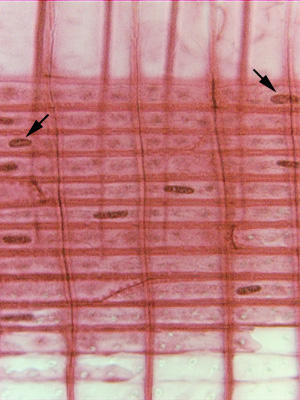 Fig.
15.2-7. Radial section of balsam fir (Abies balsamea). These
ray parenchyma cells shown here were
still alive when the sample was collected (arrows indicate several
nuclei). The sample must have been taken from the sapwood of a living tree, then
preserved with FAA or some other fixative. Very often, wood samples are taken
from dead pieces of lumber, so all cells in the microscope slide are empty,
giving the impression that all wood always consists of dead cells. But in fact, the sapwood of all trees has a considerable amount
of living parenchyma cells, at least in the rays.
Fig.
15.2-7. Radial section of balsam fir (Abies balsamea). These
ray parenchyma cells shown here were
still alive when the sample was collected (arrows indicate several
nuclei). The sample must have been taken from the sapwood of a living tree, then
preserved with FAA or some other fixative. Very often, wood samples are taken
from dead pieces of lumber, so all cells in the microscope slide are empty,
giving the impression that all wood always consists of dead cells. But in fact, the sapwood of all trees has a considerable amount
of living parenchyma cells, at least in the rays.
There are no ray tracheids here.